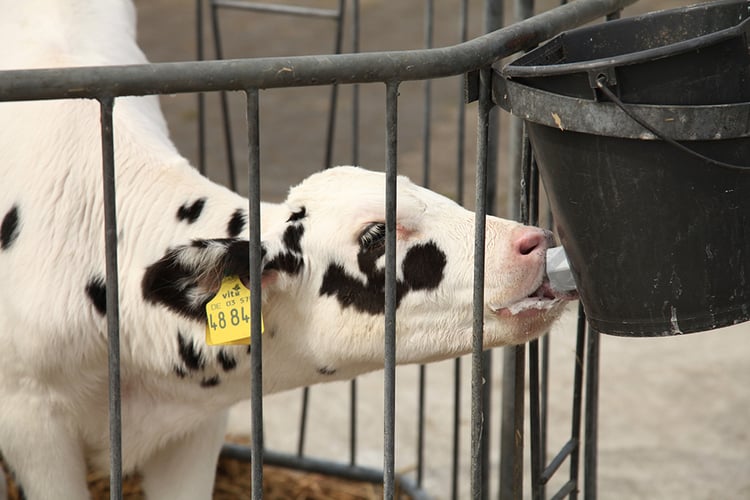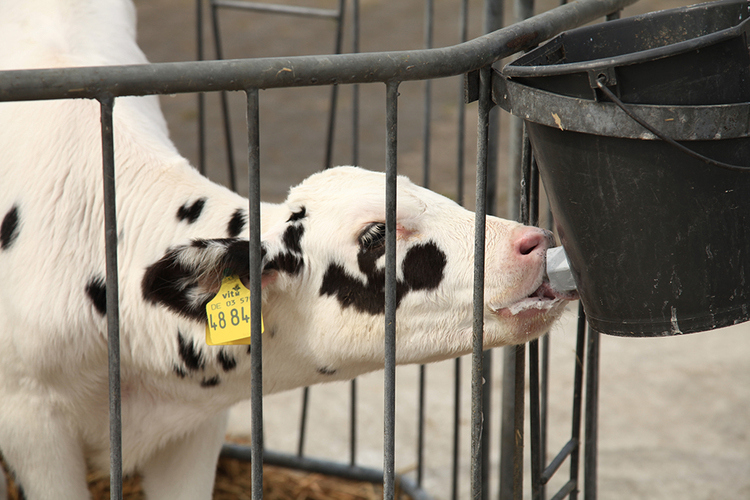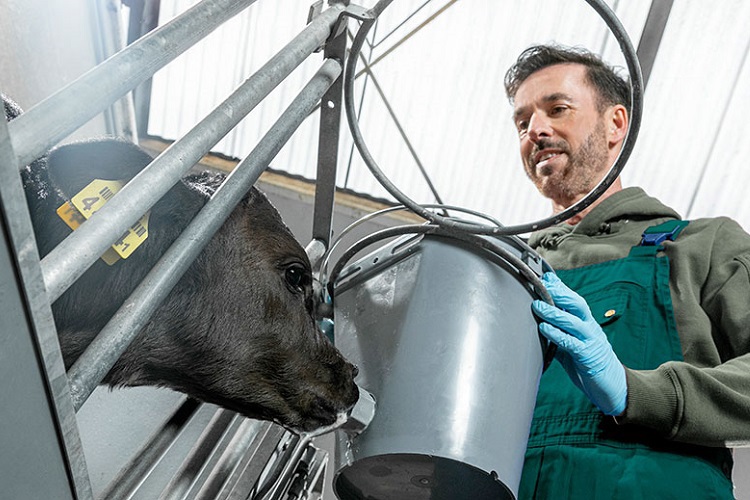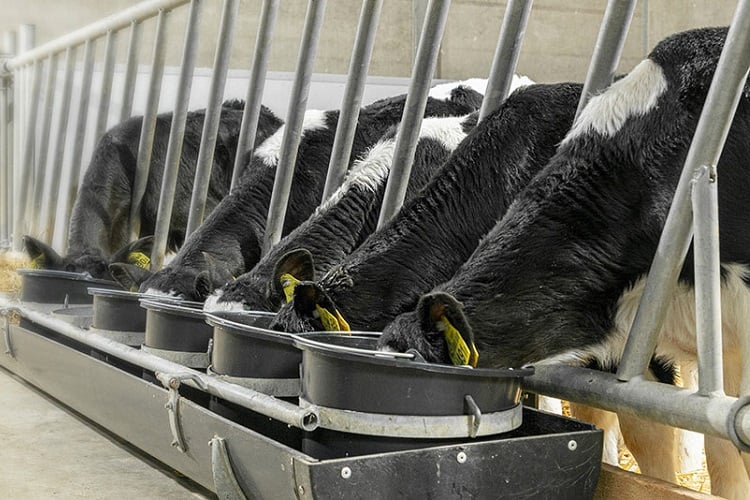
- LifeStart
- Role of fat in calf nutrition
- Lifestart themes
Key takeaways from the research
-
Calves regulate their intake of milk replacer based on energy density
-
Exchanging part of the lactose has no effect on the performance of dairy calves
-
Calves fed milk replacer where lactose was exchanged for fat exhibited fewer signs of hunger during weaning

Calves fed a CMR with a higher amount of fat express fewer signs of hunger at weaning
In recent years, nutritional strategies in calf rearing have focused on promoting strong growth rates during the milk feeding phase[1]. This can be achieved via higher feed rates[2] or modifying milk replacer composition to influence overall nutrient intake[3]. Research has shown both short and longer benefits of providing an elevated plane of nutrition in early life. These include higher weight gains, more natural feeding behaviours in calves[1] alongside improved health, feed efficiency and first lactation performance[4,5,6]. Echeverry-Munera et al evaluated responses to partially exchanging lactose with fat in MR formulations on ad libitum voluntary feed intake, growth, and feeding behaviour.
Study design
A total of 32 male Holstein calves were enrolled in the study and were assigned to one of two treatments: an MR with high lactose or an MR with high fat. The high-fat MR treatment was designed to resemble the fat content in whole milk and the high lactose MR aimed to represent commonly available formulations. Calves were monitored for 84d with the experimental period divided into 3 phases: preweaning (1-35d), weaning (36-57d) and postweaning (58-84d).
Calves were housed in individual pens for the first two weeks, being fed ad-libitum MR through teat buckets. MR was refreshed twice per day with unlimited access to water and without access to solid feed. At the end of the two weeks’ calves were grouped with 8 calves per pen, being fed ad-libitum MR through automated milk dispensers. Calves were also fed starter feed, chopped straw and water via automated feeders/bowls. MR was fed at 150g/litre and weaning was gradual over a 21-day period. Environment (e.g. temperature, humidity and light) were monitored and controlled. Milk replacer intake and starter feed intakes were measured. Feeding behaviours such as time and duration of each meal and rewarded/unrewarded were recorded. Bodyweight and body measurements were measured on the day of arrival and thereafter on a weekly basis. Blood samples were taken at arrival and on weeks 2, 4, 6, 8, 10 and 12. Fecal scores were assessed daily during the individually housed phase.
Results and conclusion
Increasing fat content at the expense of lactose decreased MR intake during the preweaning phase when calves were being fed ad-libitum, however, during the weaning phase, no differences were observed. In addition, no differences were observed in starter intake throughout the entire experimental period. No difference in rewarded visits was reported between treatments during the preweaning phase. However, once MR was restricted during the weaning phase high lactose calves were reported to have more unrewarded visits to the automatic milk feeder than high-fat calves
In the current study, increasing fat at the expense of lactose resulted in a lower voluntary intake of MR during the preweaning period. These results support the study hypothesis and are in line with previous research. The difference in caloric density between the treatments was the primary factor behind the difference in feed consumption, therefore we can conclude that energy supply regulation was driving feed intake during the preweaning period. Overall, there was no difference in starter intake between treatments, which agrees with earlier findings in calves fed MR containing high levels of fat[7,8].
High lactose MR calves were displaying more hunger-related behaviours than HF calves. Therefore, further studies should investigate the relationship between satiety control and MR formulation. Additionally, this association in relation to calf stress and welfare deserves further attention.
References
[1] Khan, M. A., D. M. Weary, and M. A. G. von Keyserlingk. 2011. Invited review: Effects of milk ration on solid feed intake, weaning, and performance in dairy heifers. J. Dairy Sci. 94:1071–1081.
[2] Rosenberger, K., J. H. C. Costa, H. W. Neave, M. A. G. von Keyserlingk and D. M. Weary. 2017. The effect of milk allowance on behaviour and weight gains in dairy calves. J. Dairy Sci. 100:504–512.
[3] Silva, A. L., M. I. Marcondes, E. Detmann, F. S. Machado, S. C.Valadares Filho, A. S. Trece, and J. Dijkstra. 2015. Effects of raw milk and starter feed on intake and body composition of Holstein x Gyr male calves up to 64 days of age. J. Dairy Sci. 98:2641– 2649.
[4] Moallem, U., D. Werner, H. Lehrer, M. Zachut, L. Livshitz, S. Yakob and A. Shamay. 2010. Long-term effects of ad libitum whole milk prior to weaning and prepubertal protein supplementation on skeletal growth rate and first-lactation milk production. J. Dairy Sci. 93:2639–2650.
[5] Bach, A. 2011. Associations between several aspects of heifer development and dairy cow survivability to second lactation. J. Dairy Sci. 94:1052–1057.
[6] Bach, A. 2012. Ruminant nutrition symposium: Optimizing performance of the offspring: Nourishing and managing the dam and postnatal calf for optimal lactation, reproduction, and immunity. J. Anim. Sci. 90:1835–1845.
[7] Amado, L., H. Berends, L. N. Leal, J. Wilms, H. Van Laar, W. J. J. Gerrits, and J. Martín-Tereso. 2019. Effect of energy source in calf milk replacer on performance, digestibility, and gut permeability in rearing calves. J. Dairy Sci. 102:3994–4001.
[8] Berends, H., H. van Laar, L. N. Leal, W. J. J. Gerrits, and J. Martín-Tereso. 2020. Effects of exchanging lactose for fat in milk replacer on ad libitum feed intake and growth performance in dairy calves. J. Dairy Sci. 103:4275–4287.






